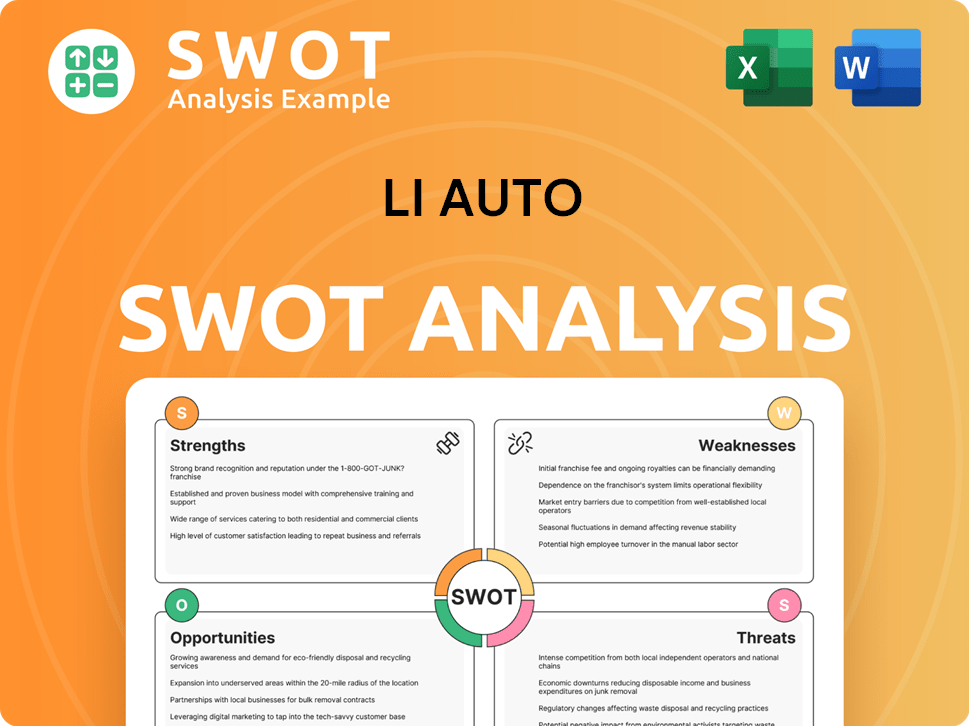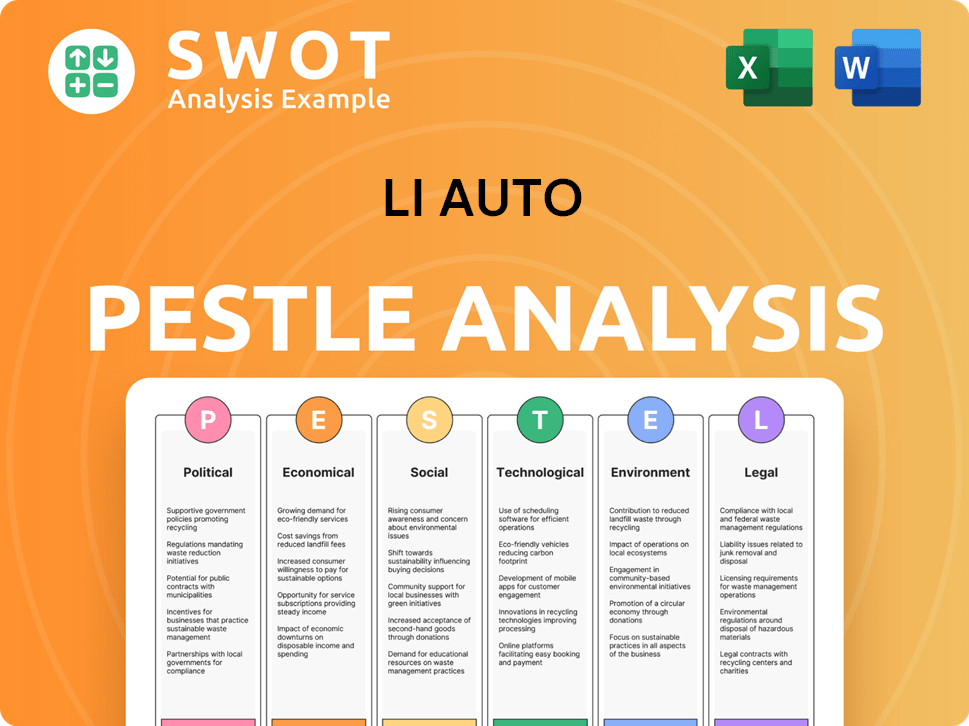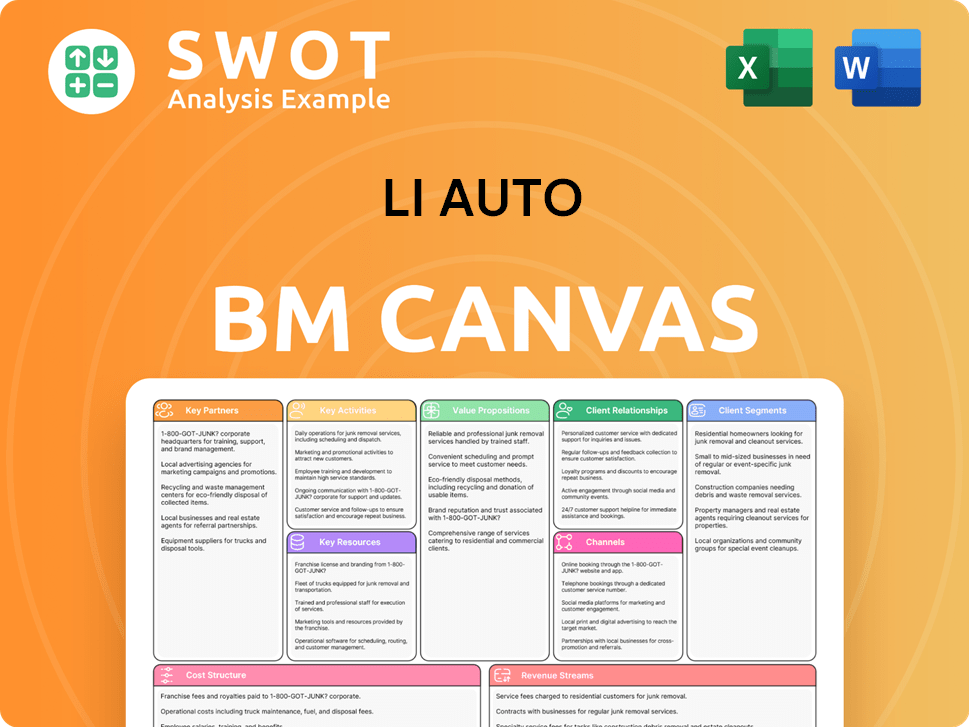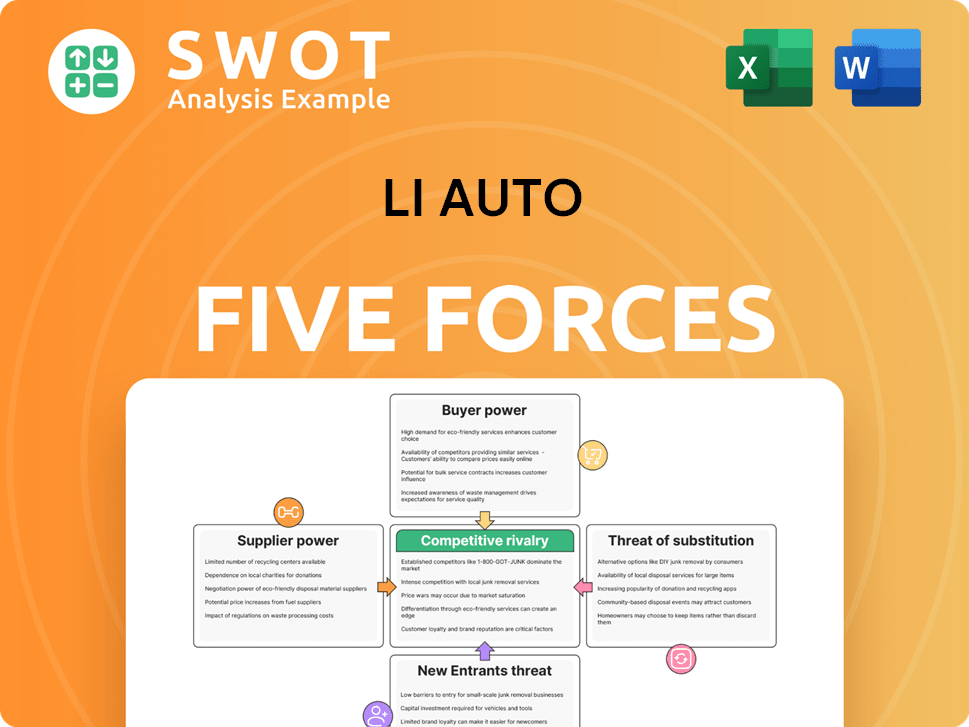Li Auto Bundle
How Did Li Auto Revolutionize China's EV Market?
Embark on a journey through the captivating Li Auto SWOT Analysis, a company that has rapidly ascended in the electric vehicle arena. From its inception in 2015, Li Auto, initially known as CHJ Automotive, has challenged industry norms with its innovative extended-range electric vehicles (EREVs). Discover how this bold strategy, addressing consumer concerns about charging infrastructure, propelled Li Auto to the forefront of China's NEV market.

This brief history of Li Auto unveils the company's evolution from a startup to a major player, exploring its founder's vision and the strategic decisions that shaped its growth. Examining Li Auto's early years and key milestones provides valuable insights into its market share gains and the development of its unique vehicle models. Understanding Li Auto's journey is crucial for anyone interested in the dynamic landscape of electric vehicles and the future of the automotive industry, including its financial performance and future plans.
What is the Li Auto Founding Story?
The story of Li Auto, a prominent player in the electric vehicle market, began on July 1, 2015. The company's inception was spearheaded by Li Xiang, the current Chairman and CEO, whose prior experience significantly shaped the company's direction. His vision addressed a critical need in the burgeoning EV market.
Li Xiang's background, particularly his founding of Autohome, provided him with a deep understanding of the Chinese automotive landscape. This insight was crucial in identifying a market gap and formulating Li Auto's strategy. The company's focus on Extended-Range Electric Vehicles (EREVs) was a direct response to the range anxiety concerns prevalent among potential EV buyers.
The initial business model of Li Auto centered around the design and manufacturing of premium smart EREVs. The first product, the 'Li One,' was conceived as a large SUV utilizing an extended-range electric powertrain. The early funding for Li Auto came from Li Xiang himself and significant investments from venture capital firms, reflecting confidence in the EREV concept. The company's evolution from 'CHJ Automotive' to 'Li Auto' simplified the brand identity, directly linking it to its founder, Li Xiang. This rebranding was aimed at enhancing brand recognition and building consumer trust, leveraging Li Xiang's established reputation in the automotive sector. For more insights into the company's core principles, explore the Mission, Vision & Core Values of Li Auto.
Li Auto's founding was marked by strategic insights and a focus on addressing consumer needs in the EV market.
- Li Auto was founded on July 1, 2015, by Li Xiang.
- Li Xiang's experience with Autohome provided a deep understanding of the automotive market.
- The company initially focused on Extended-Range Electric Vehicles (EREVs) to address range anxiety.
- The first product, the Li One, was a large SUV with an EREV powertrain.
Li Auto SWOT Analysis
- Complete SWOT Breakdown
- Fully Customizable
- Editable in Excel & Word
- Professional Formatting
- Investor-Ready Format

What Drove the Early Growth of Li Auto?
The early growth of the Li Auto company focused on its extended-range electric vehicle (EREV) technology and product development. The company's initial product, the Li ONE, launched in April 2019, quickly gained popularity in China. This success helped establish Li Auto in the competitive new energy vehicle (NEV) market. Check out the Target Market of Li Auto for more insights.
The Li ONE's launch in April 2019 marked a significant milestone for Li Auto. The SUV quickly became a top-selling NEV in China. The Li ONE's success demonstrated the effectiveness of Li Auto's EREV technology and market strategy.
To support production and sales, Li Auto rapidly expanded its team across various departments. The company established its initial manufacturing facility in Changzhou, Jiangsu Province. This expansion was crucial for meeting the growing demand for its vehicles.
The Li ONE was well-received by consumers, particularly those valuing its practicality and long-distance capabilities. Li Auto differentiated itself from competitors through its EREV technology, focusing on the premium SUV segment. This strategic focus helped Li Auto gain a strong market position.
Major capital raises were essential for funding Li Auto's expansion. The company's IPO on the Nasdaq in July 2020 raised approximately $1.1 billion. A secondary listing on the Hong Kong Stock Exchange in August 2021 further strengthened its financial position. These funds supported research and development, new product launches, and the expansion of its sales and service network.
Li Auto PESTLE Analysis
- Covers All 6 PESTLE Categories
- No Research Needed – Save Hours of Work
- Built by Experts, Trusted by Consultants
- Instant Download, Ready to Use
- 100% Editable, Fully Customizable

What are the key Milestones in Li Auto history?
The Li Auto company has achieved several significant milestones since its inception, marking its growth and expansion in the automotive industry.
| Year | Milestone |
|---|---|
| 2015 | The company was founded by Li Xiang. |
| 2019 | The Li ONE, the company's first EREV (Extended Range Electric Vehicle) model, was launched. |
| 2020 | Li Auto went public, listing on the NASDAQ under the ticker symbol "LI". |
| 2023 | Li Auto delivered over 376,000 vehicles, a substantial increase from previous years. |
| 2024 | The company launched the Li Mega, its first pure electric MPV. |
Li Auto has consistently focused on technological advancements, particularly in its EREV technology, enhancing battery efficiency and range. The company has also invested heavily in smart vehicle technology, including advanced driver-assistance systems (ADAS) and intelligent cockpit features.
Li Auto has continuously improved its EREV technology, focusing on enhancing battery efficiency and the performance of its range extenders. This has allowed for increased driving range and reduced reliance on external charging.
The company has invested significantly in advanced driver-assistance systems (ADAS) and intelligent cockpit features. These features aim to provide a superior user experience, enhancing safety and convenience for drivers.
Li Auto is constantly working on improving its battery technology to increase the range and efficiency of its electric vehicles. This includes research and development in battery chemistry and management systems.
Li Auto utilizes over-the-air (OTA) updates to improve vehicle software and add new features. This allows for continuous improvement and enhancement of the user experience without the need for physical service visits.
Li Auto has faced challenges such as skepticism about EREVs and supply chain disruptions, especially during the semiconductor shortage. The competitive NEV market in China has also required the company to constantly innovate and differentiate its offerings.
The Chinese NEV market is highly competitive, with numerous domestic and international players. This competition has driven Li Auto to innovate and differentiate its products to maintain its market position.
Supply chain disruptions, particularly during the global semiconductor shortage, have posed challenges to production and delivery schedules. Li Auto has worked to mitigate these issues through strategic partnerships and supply chain management.
The evolving market preference for pure BEVs has presented a challenge, leading Li Auto to diversify its product portfolio. The introduction of pure BEV models like the Li Mega reflects this strategic shift.
Li Auto Business Model Canvas
- Complete 9-Block Business Model Canvas
- Effortlessly Communicate Your Business Strategy
- Investor-Ready BMC Format
- 100% Editable and Customizable
- Clear and Structured Layout

What is the Timeline of Key Events for Li Auto?
The Li Auto history began on July 1, 2015, when Li Xiang established the company, initially named CHJ Automotive. The company launched its first extended-range electric vehicle (EREV) model, the Li ONE, in April 2019, marking a significant step in its early years. In July 2020, Li Auto completed its Initial Public Offering (IPO) on the Nasdaq, followed by a secondary listing on the Hong Kong Stock Exchange in August 2021. The company expanded its product line with the Li L9 in June 2022, followed by the Li L8 in September 2022 and the Li L7 in February 2023. Li Auto achieved record deliveries in 2023, exceeding 376,000 vehicles, and launched its first pure electric vehicle, the Li Mega MPV, in March 2024. The company's strong performance continued into April 2024, with robust first-quarter delivery numbers.
| Year | Key Event |
|---|---|
| 2015 | Li Auto founder Li Xiang founded the company (initially CHJ Automotive). |
| 2019 | The Li ONE, Li Auto's first EREV model, was launched. |
| 2020 | Li Auto completed its IPO on the Nasdaq stock exchange. |
| 2021 | Li Auto completed a secondary listing on the Hong Kong Stock Exchange. |
| 2022 | Li Auto unveiled the Li L9, and launched the Li L8. |
| 2023 | The Li L7 was launched, and Li Auto delivered over 376,000 vehicles. |
| 2024 | Li Auto launched the Li Mega MPV and reported strong Q1 delivery numbers. |
Li Auto plans to expand its vehicle lineup, particularly with more Battery Electric Vehicle (BEV) models. This expansion is a key part of the Li Auto future plans to meet the growing demand for electric vehicles. The company is strategically positioning itself to capture a larger share of the premium NEV market in China and beyond.
Investment in autonomous driving technologies remains a priority for Li Auto. Development of a robust charging infrastructure is also crucial for supporting its growing BEV fleet. These advancements aim to improve the driving experience and provide added convenience for consumers, enhancing Li Auto's competitive edge.
Li Auto is focused on further penetrating the premium NEV market within China. Long-term considerations include potential international expansion, although the primary focus remains on the domestic market. The company's strategic approach involves leveraging its strong brand presence and a diversified product portfolio.
Analysts predict continued strong growth for Li Auto, driven by its diverse product offerings and strong brand recognition. The company anticipates delivering between 105,000 and 110,000 vehicles in the second quarter of 2024. The company's financial performance is a key indicator of its success in the competitive NEV market.
Li Auto Porter's Five Forces Analysis
- Covers All 5 Competitive Forces in Detail
- Structured for Consultants, Students, and Founders
- 100% Editable in Microsoft Word & Excel
- Instant Digital Download – Use Immediately
- Compatible with Mac & PC – Fully Unlocked

Related Blogs
- What is Competitive Landscape of Li Auto Company?
- What is Growth Strategy and Future Prospects of Li Auto Company?
- How Does Li Auto Company Work?
- What is Sales and Marketing Strategy of Li Auto Company?
- What is Brief History of Li Auto Company?
- Who Owns Li Auto Company?
- What is Customer Demographics and Target Market of Li Auto Company?
Disclaimer
All information, articles, and product details provided on this website are for general informational and educational purposes only. We do not claim any ownership over, nor do we intend to infringe upon, any trademarks, copyrights, logos, brand names, or other intellectual property mentioned or depicted on this site. Such intellectual property remains the property of its respective owners, and any references here are made solely for identification or informational purposes, without implying any affiliation, endorsement, or partnership.
We make no representations or warranties, express or implied, regarding the accuracy, completeness, or suitability of any content or products presented. Nothing on this website should be construed as legal, tax, investment, financial, medical, or other professional advice. In addition, no part of this site—including articles or product references—constitutes a solicitation, recommendation, endorsement, advertisement, or offer to buy or sell any securities, franchises, or other financial instruments, particularly in jurisdictions where such activity would be unlawful.
All content is of a general nature and may not address the specific circumstances of any individual or entity. It is not a substitute for professional advice or services. Any actions you take based on the information provided here are strictly at your own risk. You accept full responsibility for any decisions or outcomes arising from your use of this website and agree to release us from any liability in connection with your use of, or reliance upon, the content or products found herein.